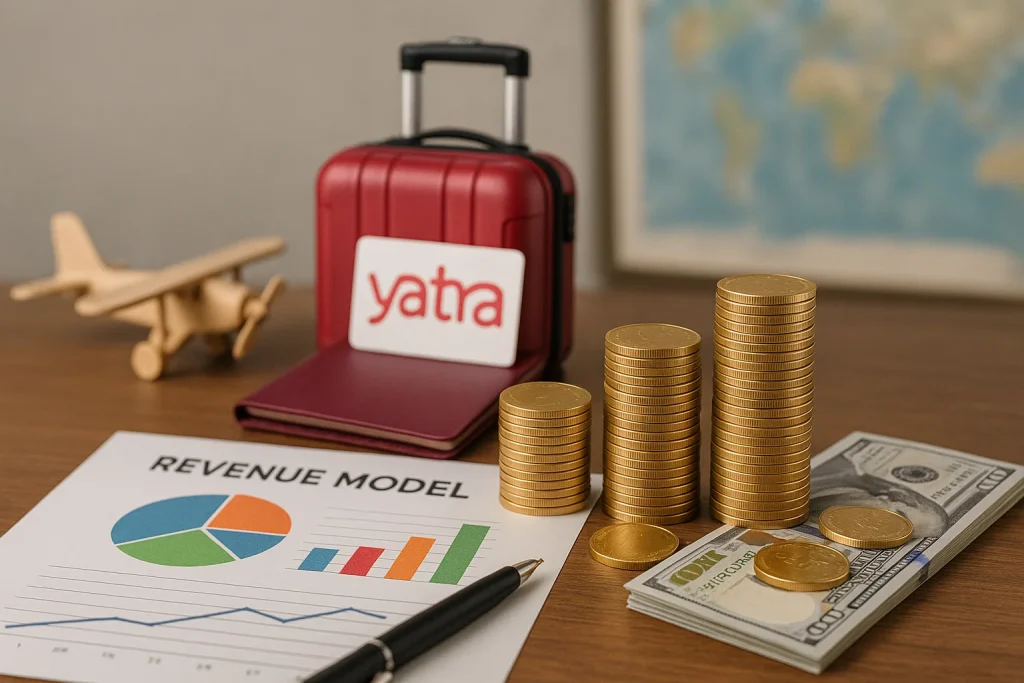Planning a holiday, business trip, or spiritual getaway? There’s a good chance you’ve booked something through Yatra — one of India’s leading online travel agencies (OTAs). But beyond helping users find flights and hotel deals, Yatra is also a finely tuned revenue-generating machine. Its business model is smart, diversified, and built to scale in 2025’s hyper-competitive travel tech landscape.
In this blog, we’ll decode the revenue model of Yatra, explore how it earns money, and show you how your startup can replicate its success using a ready-made Yatra Clone by Miracuves.
Whether you’re a startup founder, a SaaS entrepreneur, or a digital agency looking to enter the booming online travel space, understanding Yatra’s monetization strategy can give you the blueprint for building a scalable, profitable platform — fast.

What Yatra Does and Its Market Impact
Yatra.com is a comprehensive online travel agency (OTA) that offers a wide range of services including:
- Flight bookings (domestic and international)
- Hotel reservations
- Bus, train, and cab bookings
- Holiday packages
- Activities and experiences
- Travel insurance
- Corporate travel solutions
Founded in 2006, Yatra quickly emerged as one of India’s top travel portals, serving both B2C and B2B segments. It caters to millions of users annually and has established partnerships with over 100,000 hotels in India and global hotel chains and airlines.
Market Reach and Impact
- Over 12 million app downloads
- INR 3,000+ crore in gross booking revenue (recent estimates)
- Trusted by individuals and enterprises alike — including over 850 corporate clients
- Publicly listed on NASDAQ via a reverse merger in 2016
Yatra’s success is built on offering convenience, competitive pricing, and a user-friendly experience. But what powers its engine is its multi-stream revenue model — an approach that blends commissions, advertising, corporate partnerships, and more.
Discover the Yatra app marketing strategy that transformed a train-ticketing service into one of India’s most trusted travel brands.
How Yatra Makes Money
Yatra’s monetization strategy is built on diverse and scalable revenue streams that tap into both B2C and B2B markets. Here’s a quick look at how Yatra earns money:
- Commission on Bookings – From flights, hotels, buses, and holiday packages
- Service Fees – Charged on select bookings for added services
- Corporate Travel Solutions – Customized travel management for businesses
- Advertising Revenue – Display ads, featured listings, and brand promotions
- Affiliate Partnerships – Earnings via third-party travel services and referrals
- Premium Packages & Travel Insurance – Add-ons that enhance user bookings
- White-Label Solutions – Technology licensing and platform partnerships
Each of these streams contributes to a robust and resilient revenue model, which allows Yatra to thrive even during market shifts or seasonal travel slumps.
Wondering how Yatra scaled to dominate India’s travel market? Discover the Yatra business model and the strategies behind its success.
Detailed Breakdown of Revenue Channels
Let’s dive deeper into how each income stream fuels Yatra’s business and why these monetization tactics work so well:
1. Commission on Bookings
How it works:
Yatra earns a percentage-based commission from airlines, hotels, and bus operators for every successful booking made through its platform.
Who pays:
Suppliers (hotels, airlines, etc.) pay Yatra for listing and converting bookings via its platform.
Why it scales:
As user volume grows, the number of transactions increases — leading to higher cumulative commissions without increasing overhead.
Example:
Yatra reportedly earns 5–8% on flight bookings and 15–25% on hotel reservations, depending on supplier agreements.
2. Corporate Travel Solutions
How it works:
Yatra provides customized travel dashboards and booking portals for companies, managing employee travel, approvals, and reimbursements.
Who pays:
Businesses pay Yatra either via subscription fees or per-use service fees.
Why it scales:
Enterprise clients ensure recurring revenue, high ticket sizes, and long-term partnerships.
3. Service Charges & Convenience Fees
How it works:
Yatra charges customers a convenience fee on select bookings (e.g., flight cancellation, rescheduling, or priority support).
Who pays:
End users.
Why it scales:
Adds incremental revenue without depending on external providers.
Example:
Service fees for flight bookings can range between ₹150 to ₹500 per booking.
4. Advertising Revenue
How it works:
Hotels, airlines, and travel-related brands pay Yatra to feature their listings, run display ads, or promote offers across the app and website.
Who pays:
Travel partners and third-party advertisers.
Why it scales:
More traffic means more ad impressions, higher visibility, and higher ad rates.
5. Affiliate and Partnership Programs
How it works:
Yatra integrates third-party services like forex, travel cards, visa processing, and earns a cut for each successful conversion.
Who pays:
Affiliate partners.
Why it scales:
Diversifies revenue without managing service delivery in-house.
6. Travel Insurance & Add-Ons
How it works:
Customers are offered optional add-ons like travel insurance, hotel upgrades, or early check-ins at checkout.
Who pays:
End users.
Why it scales:
Capitalizes on upselling and enhances average order value.
7. White-Label Technology Solutions
How it works:
Yatra licenses its platform to smaller travel agencies and partners via white-label offerings, allowing them to sell under their own brand.
Who pays:
B2B clients and partners.
Why it scales:
Enables tech monetization beyond consumer traffic and offers high-margin income.
Learn how the Yatra app features created a user-friendly ecosystem, and why startups can adopt these features for competitive travel apps.
Optional Revenue Chart:
| Revenue Channel | Payer | Revenue Type | Scalable? |
|---|---|---|---|
| Booking Commissions | Suppliers | Transactional | ✅ |
| Corporate Travel Services | Businesses | Subscription/Usage | ✅✅ |
| Convenience & Service Fees | Consumers | Transactional | ✅ |
| Advertisements | Partners/Brands | Display/Promo | ✅✅ |
| Affiliate Commissions | Third-Party Vendors | Referral | ✅ |
| Insurance & Add-ons | Consumers | Upselling | ✅ |
| White-Label Platforms | B2B Clients | Licensing | ✅✅ |
Why This Revenue Model Works in 2025
Yatra’s revenue strategy thrives in 2025 due to a mix of evolving travel behaviors, tech innovation, and post-pandemic demand shifts. Let’s unpack why its monetization model is not just effective — but future-ready.
1. Rise in Digitally-Driven Travel Planning
Consumers now prefer self-service, app-first travel booking — eliminating traditional agents. Yatra’s model capitalizes on this with a mobile-first, commission-based approach and layered service fees that scale with user growth.
2. Rebound of Leisure & Business Travel
Post-COVID, both vacation and corporate travel have surged, particularly in Tier 2 and Tier 3 cities. With hybrid work setups, flexible holiday planning and corporate bookings are on the rise — boosting both B2C and B2B revenue streams for platforms like Yatra.
3. AI & Personalization Drive Higher Order Value
Yatra leverages dynamic pricing, personalized upsells, and automated support to improve margins and enhance user satisfaction — a critical factor for monetizing at scale in 2025.
4. Asset-Light but Scalable
Yatra’s business doesn’t rely on owning flights or hotels. Its OTA model is asset-light, relying on integrations and partnerships to generate income — which means high scalability with relatively low operational costs.
5. B2B Revenue Anchors Stability
With enterprise travel solutions and white-label partnerships, Yatra isn’t solely dependent on consumer whims or seasonality. These predictable, recurring income streams make the model financially robust.
Can Startups Replicate Yatra’s Revenue Model?
Building a Yatra-like platform from scratch demands massive effort: complex integrations with airlines and hotel APIs, a polished UI/UX, dynamic pricing logic, secure payment gateways, admin dashboards, loyalty systems, and more. Add to that — compliance, scalability, and monetization flexibility. It’s a long, expensive journey for most startups.
The Challenges of Going Solo
- Time-to-market: Custom development can take 6–12 months or more.
- Budget strain: Development costs often run into tens of thousands of dollars.
- Integration bottlenecks: Connecting with travel APIs, payment providers, and B2B systems can be overwhelming.
- User expectations: Travelers expect sleek interfaces, real-time availability, and secure bookings.
Enter Miracuves: Your Fast-Track Solution
With Miracuves’ Yatra Clone App, you get a ready-made, customizable travel booking platform equipped with:
- Flight, hotel, cab, and bus booking modules
- Commission and fee logic built-in
- Admin panel for revenue tracking
- Support for white-label and B2B extensions
- Scalable backend to support growing user demand
- Monetization-ready features: upsells, ads, insurance, subscriptions, and more
You can launch in 3-6 days not weeks, not months, with full control over branding, user flows, and revenue strategy. Plus, you can shape your monetization model to include exactly what Yatra uses — or improve on it.
Want to launch your own travel platform? Check the top Yatra clone scripts, follow our developer’s guide, and see the exact Yatra app cost breakdown for 2025.
Conclusion
Yatra has built a powerful, diversified revenue model that thrives on commissions, convenience fees, B2B partnerships, ads, and travel add-ons — all while delivering convenience to millions of travelers. It’s a prime example of how a well-structured platform can monetize every stage of the travel journey.
For startups and digital agencies looking to enter the travel tech space, replicating Yatra’s success is entirely possible — with the right technology partner.
With Miracuves’ Yatra Clone , you don’t need to reinvent the wheel. You get a pre-built, monetization-ready travel platform that mirrors Yatra’s revenue model and can be customized to your brand, niche, or geography.
FAQs
How does Yatra generate revenue?
Yatra earns money through booking commissions, convenience fees, advertising, corporate travel solutions, and add-on services like insurance and premium features. It also offers white-label travel platforms to partners for a fee.
Is Yatra profitable in 2025?
While Yatra has faced fluctuations in profitability due to travel market shifts, its diversified revenue streams and strong B2B offerings have helped it stabilize and grow in 2025. New trends like hybrid travel and digital adoption are boosting margins.
What are the main income sources for Yatra?
Yatra’s primary income comes from flight and hotel booking commissions, corporate travel management, ads, affiliate programs, and service fees on customer transactions.
Can startups use the same revenue model as Yatra?
Yes! Startups can replicate Yatra’s revenue model using a Yatra Clone App — like the one offered by Miracuves. It includes built-in monetization features, admin dashboards, and B2B support for rapid launch and growth.
Does Miracuves offer a Yatra clone with monetization features?
Absolutely. Miracuves provides a feature-rich Yatra Clone App that comes with all major monetization modules: commissions, ads, fees, subscriptions, and more. It’s fully customizable and built for startups aiming to enter the travel market quickly.








